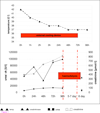A rare case of neuroleptic malignant syndrome presenting with serious hyperthermia treated with a non-invasive cooling device: a case report
- PMID: 19830098
- PMCID: PMC2726532
- DOI: 10.4076/1752-1947-3-6170
A rare case of neuroleptic malignant syndrome presenting with serious hyperthermia treated with a non-invasive cooling device: a case report
Abstract
Introduction: A rare side effect of antipsychotic medication is neuroleptic malignant syndrome, mainly characterized by hyperthermia, altered mental state, haemodynamic dysregulation, elevated serum creatine kinase and rigor. There may be multi-organ dysfunction including renal and hepatic failure as well as serious rhabdomyolysis, acute respiratory distress syndrome and disseminated intravascular coagulation. The prevalence of neuroleptic malignant syndrome is between 0.02% and 2.44% for patients taking neuroleptics and it is not necessary to fulfil all cardinal features characterizing the syndrome to be diagnosed with neuroleptic malignant syndrome. Because of other different life-threatening diseases matching the various clinical findings, the correct diagnosis can sometimes be hard to make. A special problem of intensive care treatment is the management of severe hyperthermia. Lowering of body temperature, however, may be a major clinical problem because hyperthermia in neuroleptic malignant syndrome is typically unresponsive to antipyretic agents while manual cooling proves difficult due to peripheral vasoconstriction.
Case presentation: A 22-year-old Caucasian man was admitted unconscious with a body temperature of 42 degrees C, elevated serum creatine phosphokinase, tachycardia and hypotonic blood pressure. In addition to intensive care standard therapy for coma and shock, a non-invasive cooling device (Arctic Sun 2000((R)), Medivance Inc., USA), originally designed to induce mild therapeutic hypothermia in patients after cardiopulmonary resuscitation, was used to lower body temperature. After successful treatment it became possible to obtain information from the patient about his recent ambulant treatment with Olanzapin (Zyprexa(R)) for schizophrenia.
Conclusion: Numerous case reports have been published about patients who developed neuroleptic malignant syndrome due to Olanzapin (Zyprexa(R)) medication. Frequently hyperthermia has been observed in these cases with varying outcomes. In our case the only residual impairment for the patient is dysarthria with corresponding symmetric cerebellar pyramidal cell destruction demonstrated by increased signal intensity in T2-weighted magnetic resonance imaging, most likely caused by the excessive hyperthermia.
Figures
References
-
- Franzen D, Burkhard J, Corti N, Schupbach D, Fontanel D, Staubli M. Neuroleptic malignant syndrome after 30 years treatment with clozapine: a rarely seen differential diagnosis on intensive care units. Anasthesiol Intensivmed Notfallmed Schmerzther. 2006;41:125–127. doi: 10.1055/s-2005-921089. - DOI - PubMed
-
- Pelonero AL, Levenson JL, Pandurangi AK. Neuroleptic malignant syndrome: a review. Psychiatr Serv. 1998;49:1163–1172. - PubMed
LinkOut - more resources
Full Text Sources
Other Literature Sources



